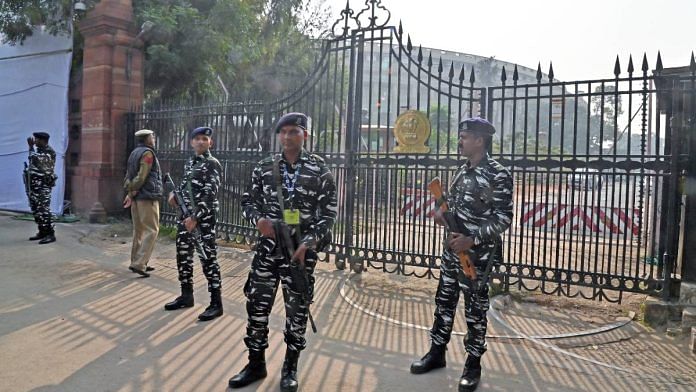New Delhi: On the anniversary of the 2001 Parliament attack Wednesday, in spite of the presence of heavy security and layers of checks, two men jumped from the visitors’ gallery in the Lok Sabha with smoke canisters before being apprehended — raising questions about how Parliament’s security protocols were breached.
In addition to the two men, another pair — a man and a woman — have been detained for protesting outside Parliament with yellow smoke, while two more people are absconding according to sources in the Delhi Police. The two in the visitors’ gallery were issued passes on the recommendation of Mysuru Bharatiya Janata Party (BJP) MP Pratap Simha, sources in Parliament said.
ThePrint tried to reach Simha for comment over the phone. This report will be updated when he responds.
Following the breach, Lok Sabha Speaker Om Birla had a discussion with the MPs on how to bolster security inside Parliament. It has now been decided that there will be a glass ceiling in the visitors gallery to prevent a repeat of such incidents in future.
Besides this, Parliament will now have body scan machines in addition to the door frame metal detectors. Also the main gate of Parliament will from now on be restricted for the entry of only MPs. Both journalists and Parliament staff will have separate entries. The strength of the Watch and Ward staff — the unit that ensures security inside the two Houses — will also be increased.
The security breach drew stringent criticism from opposition leaders, who questioned how the two men could compromise the stringent security measures and enter the Lok Sabha visitors’ gallery with smoke canisters.
With five layers of security in place, it’s a major lapse if a visitor was able to breach them all and “enter the Lok Sabha with the stuff that caused the smoke”, said a Rajya Sabha Secretariat official who did not want to be named.
Five layers of checks
Passes to view the house proceedings from the visitors’ gallery are issued by the Centralised Pass Issue Cell (CPIC), mainly on the recommendation of MPs.
A Lok Sabha Secretariat official told ThePrint that the concerned MP’s office first fills up the prescribed form available at CPIC for a visitor’s pass with all details such as name, age, background, Aadhaar number etc. “The form is then signed by the MP who has recommended the visitor and submitted to CPIC. A photocopy of the visitor’s Aadhaar card is also attached to the filled form,” the official said.
It is the CPIC that then issues the visitor’s pass. These are prepared one day in advance of the sitting for which they are valid. On a single day, an MP can recommend five visitors for a total of one hour.
As soon as the cards are prepared, copies are sent to the security staff and the Parliament’s Watch and Ward Office in the morning of the day for which they have been issued.
Besides MPs, visitors’ gallery cards are also issued on request from officers of the Lok Sabha and Rajya Sabha secretariats, heads of schools, colleges and other government institutions. The Bureau of Parliamentary Studies and Training, Lok Sabha Secretariat, also sponsors delegates of India and foreign countries for visits, provided all details of the intended visitors are made available at least two full days in advance.
Once the visitor gets the pass, he/she can enter the Lok Sabha or Rajya Sabha after clearing five rounds of thorough security checks.
“It’s difficult to sneak in anything past the stringent security,” the Lok Sabha official quoted earlier said.
The first round of checking happens at the entry of Parliament. Besides checking the cards, visitors are searched and frisked using a door frame metal detector and hand held metal detector.
Once inside, two more rounds of checking and frisking follow before the visitor can enter the Parliament House complex. Then, there are two more rounds before the visitor finally enters the Lok Sabha or Rajya Sabha. The men and women manning the final layer of security are from the in-house Parliament Security Service.
The Parliament security staff posted at the visitors’ gallery checking post ensure that all visitors are searched and frisked again with a door frame metal detector and hand held metal detector. They not only check the visitor’s card but also compare it with the approved list given to them.
The Watch and Ward staff inside the visitors’ gallery also maintain a very close vigil on the visitors, attempting to ensure that they maintain silence and don’t cause any disturbances — such as shouting slogans, attempting to throw pamphlets or other objectionable items, or trying to jump into the chamber.
A visitor has to sign a register with his/her name, address and contact details. Before entering the House, the visitor has to deposit everything he/she is carrying, such as bags, pens, and mobile phones, with the security guards.
Security setup
The security setup of the Parliament complex is handled by the joint secretary (security) of the Lok Sabha. While the latter has operational jurisdiction over the Watch and Ward, the administrative authority when it comes to the Rajya Sabha vests in the Rajya Sabha Secretariat.
The security of Parliament is handled by the Parliament Security Service as well as the Delhi Police, Indo-Tibetan Border Police, and Central Reserve Police Force. The Parliament Security Service acts as the overall coordinating agency.
The unarmed Parliament Security Service staff perform security duties for safeguarding the Parliament House Complex, MPs and VVIPs.



